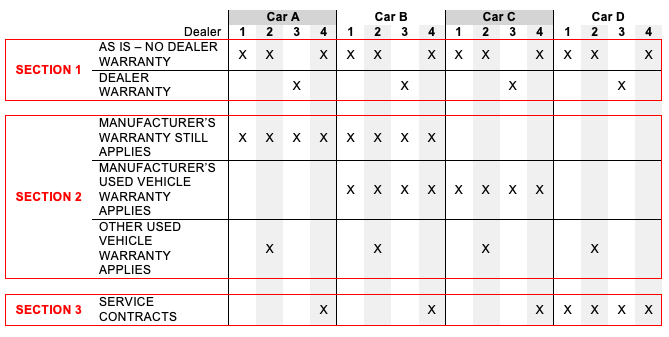Buyers Guide – Are You Creating Liability?
In November, 2016, the Federal Trade Commission (“FTC”) revised the used car Buyers Guide substantially and required all dealers to use the updated form no later than January 28, 2018. Is everyone in your organization filling out the new Buyers Guide correctly or are you unknowingly creating potential liability for your dealership?
At first glance, it appears that the Buyers Guide form includes duplicative information; however, upon closer inspection we see that the Buyers Guide has three distinct sections: (1) dealer warranties; (2) non-dealer warranties, and (3) service contracts. See our notated Buyers Guide. It is essential that you complete each section correctly to avoid creating additional unintended warranties.
Dealer Warranties (Section 1)
In the first (and largest typeface) section, a dealer must determine whether to mark “AS IS – NO DEALER WARRANTY” or “DEALER WARRANTY.” A dealer must always mark one or the other. If a dealer does not fill out this section correctly, it may be open consumer claims based on implied and express warranties the dealer did not intend to make with your vehicles. Most dealers should mark the box next to “AS IS – NO DEALER WARRANTY” for every used motor vehicle. It does not matter what warranties, if any, the manufacturer or any other third party provides for the vehicle or whether the dealer pays for any such third party warranty. This section only considers whether the dealer itself provides any direct warranties for the vehicle.
The only time a dealer should mark “DEALER WARRANTY” is if the dealership (not through the manufacturer or any third party provider) provides a direct warranty on the vehicle. In other words, if there are repairs or replacements under the warranty, the dealership will directly pay for such repairs and replacements. If your dealership provides a direct warranty for any used vehicles, you should consult your legal counsel on how to complete the remaining portions of the first section of the Buyers Guide relating to full vs. limited warranty, systems covered, and duration.
Non-Dealer Warranties (Section 2)
The second section includes three distinct options that provide in part: (i) “MANUFACTURER’S WARRANTY STILL APPLIES”; (ii) “MANUFACTURER’S USED VEHICLE WARRANTY APPLIES; and (iii) “OTHER USED VEHICLE WARRANTY APPLIES. In this section, it may be proper not to check any boxes, to check one box, or even two or three boxes at the same time. A dealer should only check the first box if the manufacturer’s original warranty from the first date of sale still applies to the vehicle. A dealer should only check the second box if the manufacturer (not a third party) provides some warranty to the vehicle other than the original warranty from the first date of sale (i.e. the vehicle is in the manufacturer’s certified pre-owned or other similar program). A dealer should check the third box if there is any third party (not dealer or manufacturer) warranty for the vehicle that is included with the vehicle at no charge to the consumer.
Service Contracts (Section 3)
The final disclosure section of the Buyers Guide involves “service contracts.” This section is a little misleading because it does not only refer to a service contract the dealer provides to the consumer (e.g. oil changes for life, tire rotations, etc.). The FTC also considers any warranty provided at additional cost to the consumer (i.e. not included in the purchase price of the vehicle) as a “service contract.” For example, if the used vehicle is eligible for a certified pre-owned warranty, but the warranty does not come with the vehicle and the consumer must pay extra for such certification, then the dealer must check the “service contract” box and not the “MANUFACTURER’S USED VEHICLE WARRANTY APPLIES.”
Examples
Consider the following dealer programs:
- Dealer 1: Does not provide or include any dealer or third party (other than manufacturer) warranty with any vehicles.
- Dealer 2: Does not provide or include any direct dealer warranty. Includes an additional limited powertrain warranty from a third party provider at no additional cost to the consumer.
- Dealer 3: Provides a full 30-day dealer warranty. Does not include any additional warranties on its used vehicles from any third party provider at no additional cost to the consumer.
- Dealer 4: Does not provide or include any dealer or third party (other than manufacturer) warranty with any vehicles. Does provide free oil changes for 12 months.
And the following four vehicles:
- Car A: 1 year old with 10,000 miles and no disqualifying events (within applicable manufacturer warranty periods).
- Car B: Same as Car A, but the vehicle includes a Certified Pre-Owned (or similar program) warranty from the manufacturer at no additional cost to the consumer.
- Car C: 4 years old (outside manufacturer initial warranty), but comes with a Certified Pre-Owned (or similar program) warranty from the manufacturer at no additional cost to the consumer.
- Car D: 6 years old with 150,000 miles (completely outside all manufacturer warranty periods), but the consumer elects to purchase a warranty/service contract from a third party provider that dealer sells.
In these cases, each dealer should complete the front page of the Buyers Guide as follows:

Completing the Sale
It is also important to note that the Buyers Guide is fluid until the dealer completes the sale to the consumer. As such, the dealer is under an affirmative duty to update the Buyers Guide if any of the representations change for any reason, including negotiation with the consumer. We Owes and other similar notes on other sale documents do not relieve the dealer from its obligation to ensure that the Buyers Guide is correct at the time of sale and that the consumer receives the original, corrected Buyers Guide.
